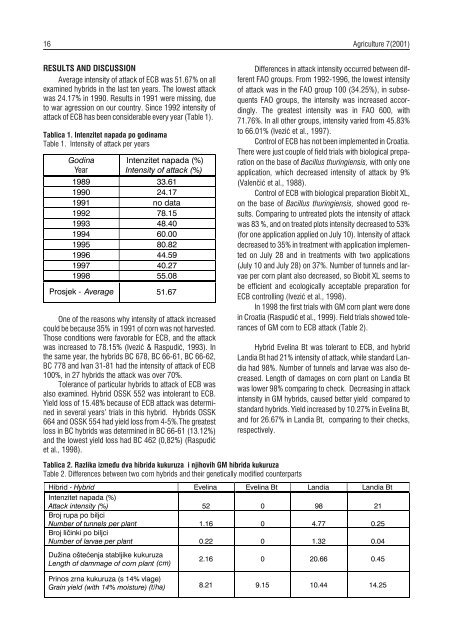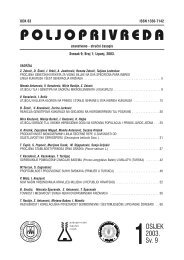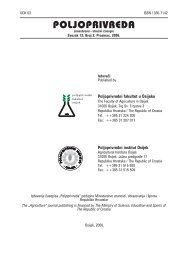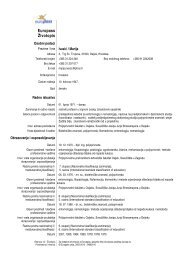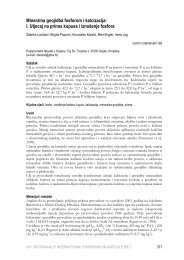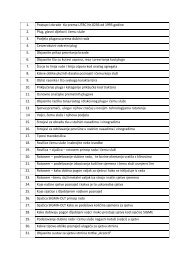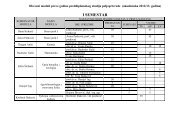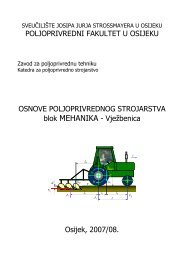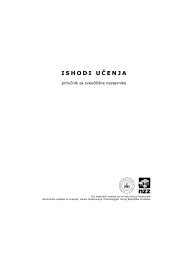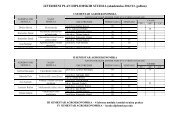c:\Temp\PDF_RTF\poljoprivreda\Poljoprivreda 1-2001\Poljoprivreda ...
c:\Temp\PDF_RTF\poljoprivreda\Poljoprivreda 1-2001\Poljoprivreda ...
c:\Temp\PDF_RTF\poljoprivreda\Poljoprivreda 1-2001\Poljoprivreda ...
You also want an ePaper? Increase the reach of your titles
YUMPU automatically turns print PDFs into web optimized ePapers that Google loves.
16 Agriculture 7(2001)<br />
RESULTS AND DISCUSSION<br />
Average intensity of attack of ECB was 51.67% on all<br />
examined hybrids in the last ten years. The lowest attack<br />
was 24.17% in 1990. Results in 1991 were missing, due<br />
to war agression on our country. Since 1992 intensity of<br />
attack of ECB has been considerable every year (Table 1).<br />
Tablica 1. Intenzitet napada po godinama<br />
Table 1. Intensity of attack per years<br />
One of the reasons why intensity of attack increased<br />
could be because 35% in 1991 of corn was not harvested.<br />
Those conditions were favorable for ECB, and the attack<br />
was increased to 78.15% (Ivezi} & Raspudi}, 1993). In<br />
the same year, the hybrids BC 678, BC 66-61, BC 66-62,<br />
BC 778 and Ivan 31-81 had the intensity of attack of ECB<br />
100%, in 27 hybrids the attack was over 70%.<br />
Tolerance of particular hybrids to attack of ECB was<br />
also examined. Hybrid OSSK 552 was intolerant to ECB.<br />
Yield loss of 15.48% because of ECB attack was determined<br />
in several years’ trials in this hybrid. Hybrids OSSK<br />
664 and OSSK 554 had yield loss from 4-5%.The greatest<br />
loss in BC hybrids was determined in BC 66-61 (13.12%)<br />
and the lowest yield loss had BC 462 (0,82%) (Raspudi}<br />
et al., 1998).<br />
Differences in attack intensity occurred between different<br />
FAO groups. From 1992-1996, the lowest intensity<br />
of attack was in the FAO group 100 (34.25%), in subsequents<br />
FAO groups, the intensity was increased accordingly.<br />
The greatest intensity was in FAO 600, with<br />
71.76%. In all other groups, intensity varied from 45.83%<br />
to 66.01% (Ivezi} et al., 1997).<br />
Control of ECB has not been implemented in Croatia.<br />
There were just couple of field trials with biological preparation<br />
on the base of Bacillus thuringiensis, with only one<br />
application, which decreased intensity of attack by 9%<br />
(Valen~i} et al., 1988).<br />
Control of ECB with biological preparation Biobit XL,<br />
on the base of Bacillus thuringiensis, showed good results.<br />
Comparing to untreated plots the intensity of attack<br />
was 83 %, and on treated plots intensity decreased to 53%<br />
(for one application applied on July 10). Intensity of attack<br />
decreased to 35% in treatment with application implemented<br />
on July 28 and in treatments with two applications<br />
(July 10 and July 28) on 37%. Number of tunnels and larvae<br />
per corn plant also decreased, so Biobit XL seems to<br />
be efficient and ecologically acceptable preparation for<br />
ECB controlling (Ivezi} et al., 1998).<br />
In 1998 the first trials with GM corn plant were done<br />
in Croatia (Raspudi} et al., 1999). Field trials showed tolerances<br />
of GM corn to ECB attack (Table 2).<br />
Hybrid Evelina Bt was tolerant to ECB, and hybrid<br />
Landia Bt had 21% intensity of attack, while standard Landia<br />
had 98%. Number of tunnels and larvae was also decreased.<br />
Length of damages on corn plant on Landia Bt<br />
was lower 98% comparing to check. Decreasing in attack<br />
intensity in GM hybrids, caused better yield compared to<br />
standard hybrids. Yield increased by 10.27% in Evelina Bt,<br />
and for 26.67% in Landia Bt, comparing to their checks,<br />
respectively.<br />
Tablica 2. Razlika izme|u dva hibrida kukuruza i njihovih GM hibrida kukuruza<br />
Table 2. Differences between two corn hybrids and their genetically modified counterparts


